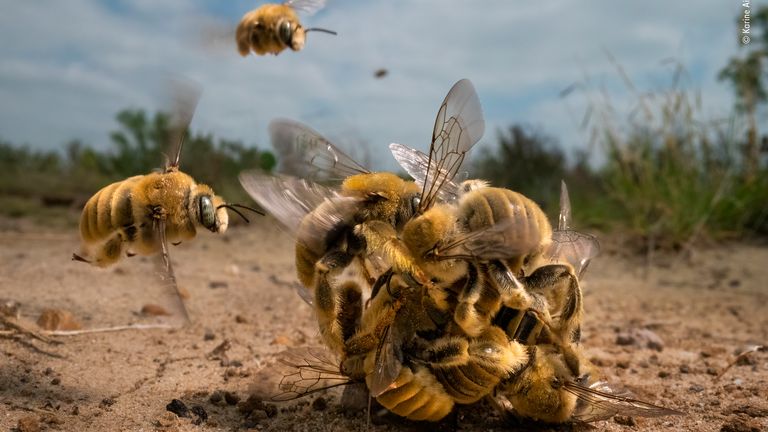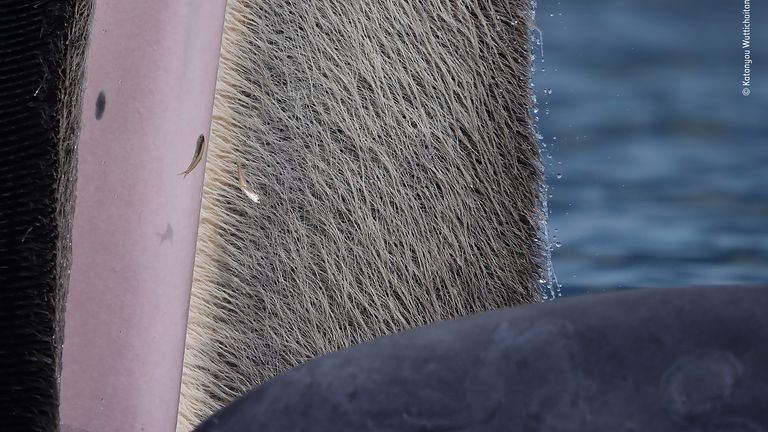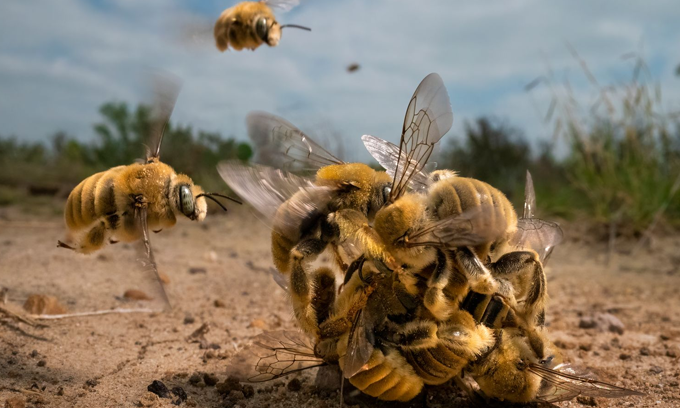(UTV | COLOMBO) – A bat-snatching snake, dying gorilla and dancing giant sea star feature among this years spectacular winning entries.

The woman behind an image of a buzzing ball of cactus bees spinning over the hot sand on a Texas ranch has been named winner of this year’s Wildlife Photographer Of The Year competition.
American photographer Karine Aignere became just the fifth woman in the competition’s 58-year history to be awarded the Grand Title award.The winners of the Natural History Museum’s prestigious Wildlife Photographer of the Year competition were announced at an awards ceremony in London on Tuesday night.
Entitled “The big buzz”, her winning shot was taken close up at bee-level and shows all except one of the male insects intent on mating with the single female at the centre.
Organisers of the contest pointed out that, like most bees, the insects pictured are threatened by habitat loss, pesticides and climate change, along with farming practices that disrupt their nesting grounds.
Chair of the jury, writer and editor Rosamund Kidman Cox OBE, said: “Wings-whirring, incoming males home in on the ball of buzzing bees that is rolling straight into the picture.
“The sense of movement and intensity is shown at bee-level magnification and transforms what are little cactus bees into big competitors for a single female.”

Meanwhile, 16-year-old Katanyou Wuttichaitanakorn, from Thailand, was awarded the Young Wildlife Photographer of the Year 2022 for his creative image, “The beauty of baleen”.
Organisers explained that when a Bryde’s whale surfaced close to the boat, Katanyou was intrigued by the contrasting colours and textures of its dark skin, pink gum and the brush-like mass of baleen hanging down from its top jaw.
Like other baleen whales, the species use a technique known as lunge-feeding to capture large numbers of small schooling fish and use the plates of baleen to filter the small prey from the ocean.
“Out of the jaws of a Bryde’s whale comes this dazzling creation,” said Ms Kidman Cox.
“The pin-sharp detail of the tiny anchovies is set against an abstraction of colour with the weave of brown baleen hair rimmed by a cascade of water drops.”
The two Grand Title winners were chosen from 19 category winners that highlight the natural world in all its wonder and diversity.
They had been picked from a total of 38,575 entries from 93 countries to be judged anonymously by an international panel of experts on their originality, narrative, technical excellence and ethical practice.
The images will go on show as part of the redesigned Wildlife Photographer of the Year exhibition from 14 October at the Natural History Museum.
Below are the individual award winners along with their categories and descriptions:
Ekaterina Bee watches as two Alpine ibex spar for supremacy. It was near the end of a spring day trip with her family that Ekaterina spotted the fight.
The two ibex clashed horns and continued to trade blows while standing on their hind legs like boxers in a ring.
In the early 1800s, following centuries of hunting, fewer than 100 Alpine ibex survived in the mountains on the Italy-France border. Successful conservation measures mean that, today, there are more than 50,000.
Out of the fog by Ismael Domínguez Gutierrez, Spain – 11 to 14 years
